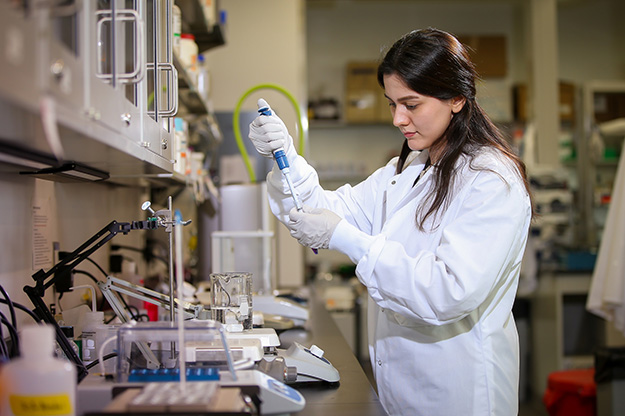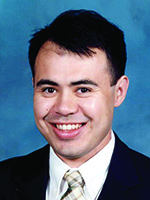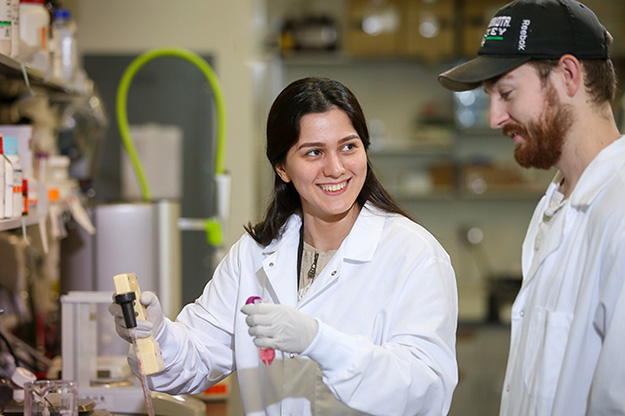Research funding relapse
Proposed cut to the National Institutes of Health would have negative effect on biomedical research, health and economy of North Dakota

When Colin Combs was selecting a research specialty as a graduate student, he had one motivation.
He wanted to make a difference.
“I chose Alzheimer’s disease because I thought it had the direst need for improvement in medical treatment,” said Combs, chair of the UND Department of Biomedical Sciences. “I wanted to address something that was a very important problem.”

Combs and his UND laboratory team are trying to understand the immune changes that happen in the brain, as well as the rest of the body, during the progression of Alzheimer’s disease. But a proposed cut to his main source of funding could stop his push for prevention.
Included in President Donald Trump’s preliminary federal budget for 2018 is a nearly 20 percent cut, or $5.8 billion, to the National Institutes of Health (NIH). The NIH typically allots 85 percent of its funding to research grants for medical institutions — grants that support investigators like Combs.
“It will have a detrimental effect on all of the efforts that have been made in the past years to try to increase our awareness and our ability to combat the disease,” Combs said of the cut.
Joshua Wynne, UND vice president for health affairs and dean of the School of Medicine and Health Sciences (SMHS), says the SMHS has multiple sources of funding to carry out its missions. “Twenty-five percent of our total budget comes from sponsored funding. That’s mostly federal funding, and of the federal funding, the largest single component is funding from the NIH,” Wynne explained.
In 2016, the SMHS received more than $12 million from the NIH. The funding consists of two components: direct costs and facilities and administrative costs (F&A).

“If either or both of those were jeopardized, it would be a major impediment to our research enterprise,” Wynne said.
IDeA Program
An additional proposal from President Trump would trim $1.2 billion from the NIH in the current fiscal year. The majority of those cuts would be research grants, $50 million of which would be from the Institutional Development Award (IDeA) program for biomedical research.
Grant McGimpsey, UND vice president for research and economic development, said that reduction is particularly worrying for North Dakota.
“The IDeA program is meant to help states that don’t get as much NIH funding to tap into some funds that are directed specifically to these states. UND is highly competitive in the IDeA program and has seen many benefits from it,” he said.
“The IDeA program tries to level the table,” Wynne added. “It tries to develop research infrastructure in the state so that a state like North Dakota and its researchers can now compete with those from California and New York and Massachusetts.”
When asked how the state comes out if these cuts happen, Wynne is direct: “North Dakota loses.”

Solving medical challenges
The biomedical discoveries happening at UND are often related to the issues that are important to North Dakotans, such as obesity, cancer and Alzheimer’s disease — all of which have significantly higher rates in North Dakota than other areas of the country. Combs’ research is especially critical.
“Alzheimer’s disease is the third-leading cause of death in North Dakota, and we have the second-highest mortality rate due to Alzheimer’s in the country,” Combs said. “This is a problem that faces our communities.”
“We need a breakthrough and we need it now. We can’t wait another five or ten years,” Wynne added.
Senior Associate Dean for Medicine and Research Marc Basson is currently leading research to understand what makes epithelial cells differentiate. This is important in understanding obesity and weight loss, as well as helping people living with a devastating disease called short gut syndrome. He says the proposed NIH cuts would be a major challenge for the research community.
“We — and everyone around the country — would likely be unable to do either the work that we are currently committed to doing or would be unlikely to do future work,” Basson said. “There would be direct and indirect impacts on the health of North Dakotans and people at large. All of the work we’re doing is to improve patient welfare, and we will lose that progress we’re making.”

Economic hit
Beyond stifling medical discoveries that directly affect North Dakotans, the proposed NIH cuts would financially impact the state.
“It will have a negative economic development impact. It will be negative for state tax revenue, because there won’t be as much money coming into the state,” McGimpsey said. “If we get $1 million of research money in, it generates around $1.8 million in economic activity in the state. We will lose that.”
Wynne added that the SMHS’s research enterprise not only leads some companies to settle in North Dakota, but it also simply employs people. “Those people then buy services, and it has a multiplier effect that’s good for the economy,” he explained.
This isn’t an economic issue that falls solely on North Dakota. Basson noted that the United States has already invested heavily in biomedical research. He says it “makes no sense” to let that investment sit inactive.
“We’ve built up a huge infrastructure — not just a physical infrastructure, but more importantly, a human infrastructure, training all these people to do this research because we think it’s important,” Basson said. “Americans are leaders scientifically in biomedical research. Our people get the best care, the best drugs, the best of everything — because it’s being developed here.”
McGimpsey doesn’t believe that the cuts to the NIH will remain at the level proposed in the preliminary budget. There has already been strong pushback in Washington, D.C. North Dakota Republican Rep. Kevin Cramer was among 207 members of Congress who signed a letter in support of funding. But if a reduction anywhere near that amount happens, America will feel the pain.
“It will decrease the amount of biomedical research going on, it will decrease the pipeline of new medical therapies into the marketplace, it will slow down cures, it will impact jobs,” McGimpsey said. “It’s just going to have a chilling effect all the way down the line.”


